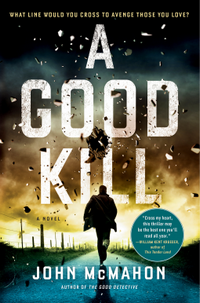 |
A Good Killby John McMahon eARC, 384 pg. Read: June 11-14, 2021 |

What’s A Good Kill About?
We open P.T. Marsh and his partner, Remy, on the grounds of a high school where an active shooter has taken some hostages. The two of them are able to bring things to a swift resolution, gaining them praise as heroes. The question stops being “who could do this” and changes into a “why did someone do this.”
Due to the staff size for this small city and that there are other crimes that need investigating, P.T. and Remy have to look into a double homicide while the other partners continue to follow up on the shooter. It’s this crime that provides most of what P.T. and Renee to go down a rabbit hole of corruption—one that might tie into the killing of his wife and son a few years back. Even if it doesn’t—it certainly ties into several deaths, drug use/sales, and other crimes.
A Word About the School Shooting
As we talked about in the Q&A yesterday, mass shootings in general—but specifically school shootings—are about as controversial as anything in American culture today. As they should be, I think I can say without getting into it. And some readers might be put off of the book because of that, this would be a mistake. First, because as McMahon said, “the subject is not entered into divisively or politically.”
Secondly, while the book starts with the school shooting—it’s not what the book is about. It’s the instigating event. It casts a shadow over everything that happens in the days following it for P.T. and the rest of Mason Falls. You can’t get away from it for long (but there are a few pages every now and then that might draw your attention away from it).
It reminded me of the Ian Rankin novel A Question of Blood, where Rebus is called to come help a friend look into a school shooting, and it turns out to be about a lot more than that. The two books approach the subject differently and go in different directions with it. But that doesn’t stop the reader from thinking about them at the same time.
Wait—You Can Do This In a Procedural?
P.T. and his partner Remy get along—they spend time with each other outside of work. Yes, they disagree on some things, but there’s a mutual affection and respect. In fact, that carries through the department—detectives and uniformed officers, every detective, even the Chief and everyone else—they look out for each other, support and help each other.* There’s no petty jealousies coloring things, no rivalry, no behind-the-scenes machinations. I cannot think of another police procedural like that, what a refreshing change.
* Okay, the Force Investigation Unit detective has something against P.T.
Now, there are politicians at various levels and federal agents from a couple of agencies—so I’m not suggesting it’s all rainbows and unicorns. In fact, things get pretty nasty on these other points. So it’s not like P.T. has nothing to worry about or put up with.
Jumping On At This Point
This is a tricky one to jump into the series with—McMahon says that he treated the three books as a series, and so jumping on with the third book brings some challenges. And no matter how well he blends in the details about what happened in the first two books, readers like me are going to miss something. But McMahon does a great job in giving you enough information from the first two books that you can jump in and get almost all the weight of the first two books on P.T. and the rest. I knew I missed out on some of the nuances, but I had no problem following things or caring about the way he wraps up this trilogy within a series.
I’m not convinced I could go back and read the first two at this point, I should add. But you never know…
Purvis!
Purvis is an eight-year-old bulldog, who had been P.T.’s son’s pet but is now P.T.’s. Not only is he good for comic relief. P.T. bounces a lot of ideas off of Purvis, who is just the listener P.T. needs. It was a really good depiction of a man and his pet, and you all know I’m a sucker for that kind of thing, and Purvis is off to a commanding lead in my “Favorite Pets of 2021” race.
There’s another dog, who seems like an adorable handful, in this book, and in P.T.’s life now. He seems like he could be a fun cast member—but the star of the K-9 action is Purvis. Still, I hope I get to see both of them again soon.
So, what did I think about A Good Kill?
There’s very little about this book that didn’t work for me—great characters; solid, twisty story; some strong action scenes; and believable criminals around at every stage. There’s more than your daily minimum requirement of fictional emotions—P.T. and Remy are put through the wringer, and you feel it at every step of the way. Which just makes the ending of the book so much more meaningful, even to people who hadn’t read the two previous books. You name it, McMahon provides it in one way or another.
All of this just makes this Crime Fiction reader all sorts of happy.
Grab this one, or the first in the trilogy, The Good Detective. You won’t regret it.
Disclaimer: I received this eARC from PENGUIN GROUP Putnam via NetGalley in exchange for this post—thanks to both for this, and to Wiley Saichek and Saichek Publicity for bringing it to my attention.

This post contains an affiliate link. If you purchase from it, I will get a small commission at no additional cost to you. As always, opinions are my own.
![]()



5 Pingbacks